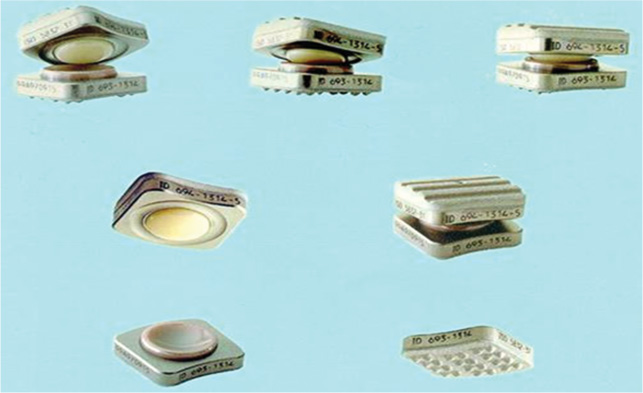11 Cervidisc Design Features (Fig. 11–1) Posterior Longitudinal Ligament Opening The time has come to evaluate the results, at 6 years, of 52 implanted Cervidiscs (Scient’x USA, Maitland, FL). Cervidisc is a mobile cervical prosthesis, first implanted June 11, 1999, in Geneva. It is made of a ceramic mobile interface surrounded by a coating of titanium, zirconium, and hydroxyapatite (Fig. 11–1). We are happy to present the encouraging results obtained with this first-generation Cervidisc. Substantial lessons have been learned and have led to Cervidisc II, a second generation, called the Discocerv (Scient’x), which is ready for a multicenter study. At this 6-year evaluation, it may be too early to know the effect of a prosthesis on the adjacent segment (s). However, adjacent segment disease remains the challenge and the real justification of a prosthesis implantation. The features and goals of the Cervidisc are: Increased patient comfort Avoidance of fusion, reduction of risk of herniation at adjacent levels, reduction of adjacent segment disease (i.e., transition syndrome) Preserved long-lasting mobility for segment Increased anterior range of motion (ROM) by a maximum of 20 degrees, increased posterior ROM by a maximum of 10 degrees, increased left-right ROM by a maximum of 5 degrees each Figure 11–1 Cervidisc.
Cervidisc Concept: Six-Year Follow-Up and
Introducing Cervidisc II: DISCOCERV
Material
Cervidisc Design Features
| Mobile Cervical Prosthesis Cervidisc |
Period | June 11, 1999 to December 15, 2003 |
Number of procedures | 46 |
Gender | 31F/15M |
Age at surgery | 49 (SD 8.78, range 25–70) |
Modular implant design Spherical motion through well-known and proven “head-cup coupling,” zirconium/Al2O3 ceramics coupling gives excellent tribology, predefined lordotic angle of 4 degrees, two different shapes for cranial component: straight, various heights (7,8,9 mm), plate size (14 × 13 mm), end plates with teeth giving good bony anchorage, hydroxyapatite coating accelerating osseointegration
Easy surgical technique Well-known and proven surgical technique from cervical fusions, one-stage insertion of the entire prosthesis, only one ancillary tool for insertion
Method
Between June 11, 1999 and December 15, 2003, the Cervidisc was implanted in 52 patients by the same neurosurgeon. Six cases were removed from the study (see Complications). The remaining forty-six patients were reviewed for long-term follow-up. There were 31 females and 15 males, aged 25 to 70 years, with a mean age of 49, as shown in Table 11–1.
Group | Description | n |
A | One single level | 23 |
B | Two levels (one Cervidisc, one cage underneath) |
 Material
Material Method
Method Complications
Complications Subsidence
Subsidence Technical Surgical Points
Technical Surgical Points Clinical Evaluation
Clinical Evaluation Conclusion
Conclusion








